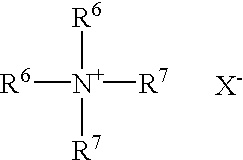Liquid detergent compositions
a technology of compositions and liquid detergents, applied in detergent compositions, detergent compounding agents, liquid soaps, etc., can solve problems such as cloudiness or even physical instability
- Summary
- Abstract
- Description
- Claims
- Application Information
AI Technical Summary
Benefits of technology
Problems solved by technology
Method used
Image
Examples
Embodiment Construction
[0092]
1 Raw material as 100% Example 1 Control Oleic acid 6.90 -- Coconut fatty acid 4.60 -- LAS acid -- 11.24 NI C.sub.12-C.sub.15 18.00 18.00 NaOH 1.05 1.01 Sodium Citrate 2 aq from 1 to 10% Sodium tetraborate 3.00 3.00 pentahydrate Propylene Glycol 5.00 5.00 Antioxidant BHT 0.04 0.00 Tinopal UNPA-GX 0.24 0.24 Alcosperse 725 0.36 0.36 PVP 0.3 0.3 Preservative Up to 100% 0.00036 Water Neutralised for 60 73 Final pH 8 8 Appearance after 1 day at Na Citrate 2 aq Room Temperature (wt %) Example 1 Control 0 Clear Clear 1 Clear Clear 2 Clear Hazy 3 Clear Unstable 4 Clear Unstable 5 Clear Unstable 6 Clear Unstable 7 Clear Unstable 8 Clear Unstable 9 Clear Unstable 10 Clear Unstable
[0093] It can be seen that the composition of Example 1 was tolerant to electrolyte over the whole range of 0-10% added citrate whereas the Control became hazy at 2% and then unstable (as evidenced by phase separation) at 3% and above.
PUM
| Property | Measurement | Unit |
|---|---|---|
| viscosity | aaaaa | aaaaa |
| viscosity | aaaaa | aaaaa |
| viscosity | aaaaa | aaaaa |
Abstract
Description
Claims
Application Information
 Login to View More
Login to View More - R&D
- Intellectual Property
- Life Sciences
- Materials
- Tech Scout
- Unparalleled Data Quality
- Higher Quality Content
- 60% Fewer Hallucinations
Browse by: Latest US Patents, China's latest patents, Technical Efficacy Thesaurus, Application Domain, Technology Topic, Popular Technical Reports.
© 2025 PatSnap. All rights reserved.Legal|Privacy policy|Modern Slavery Act Transparency Statement|Sitemap|About US| Contact US: help@patsnap.com

